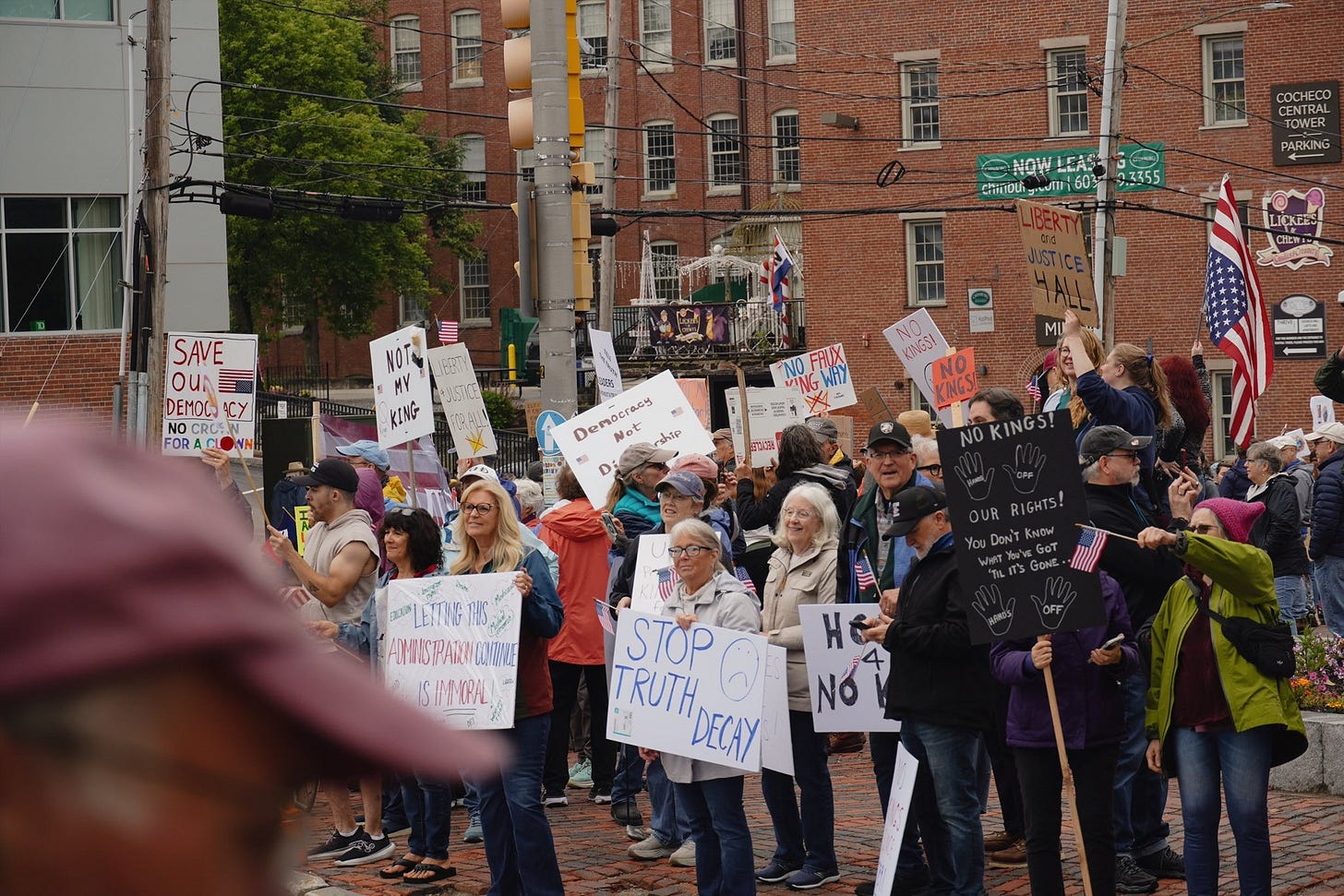A Beautiful, Broken Day in America
This is the story of June 14 and the country we keep becoming. Righteous marches. Empty parades. And one woman no one stopped to see.
Saturday morning arrived for us pretty late, and we were trying to decide whether to attend the No King Protests or buy groceries. The groceries won out. We spent $315 on a bill a year ago, which was half that amount. The cashier informed us casually and calmly that some people’s grocery cart bills had rung up to over $800. Maybe it was a bigger bill than normal due to Sunday's Father's Day BBQ events? But literally, I’m sometimes unsure how people are navigating our current economic moment.
On our way home, traffic was backed up, and I said out loud to my kid, “Wonder what’s going on?” because I’d already forgotten about the No King Protests.

Stephanie Sikes-Mitchel did a great job of capturing some of the downtown photos of the protest, to give you an idea of what the protest was like if you missed it.
We saw signs that read:
Let’s not pretend your racism is patriotism.
Love Not Hate.
Where law ends, tyranny begins.
History has its eyes on you.
No Kings! Hands Off Our Rights!
You don’t know what you’ve got 'til it’s gone...
I’m too old for this shit
No kings! Hands Off our Rights! You don’t know what you’ve got ‘til it’s gone…
What amazed me most was how well-dressed people were, how proud they were, and how happy people seemed. Righteous, joyful indignation.
Concurrently, the Trump Birthday parade was marching through DC.
Trump’s team claimed 250,000 attendees (despite empty bleachers and rain-slicked apathy).
I’m not saying people didn’t show up to the Trump Birthday party.
But the No King demonstrations didn’t just happen in downtown Dover. Best estimates put the overwhelmingly peaceful nationwide protest at around 5 million people across 2000 cities. No squeaky tanks. No teleprompters. Just bodies and signs and songs.
The San Antonio Express-News said, “the peaceful protests were a stunning rebuke to Trump and those who enable him.”1
“‘[…]we came together, powerfully and peacefully,’ said a spokeswoman for the Seattle chapter of Indivisible, one of the groups that sponsored the march. About 70,000 demonstrators marched for more than a mile to the Emerald City’s central square…from Miami to San Diego […] boisterous […and] nonviolent crowds,” reported the not exactly bastion of progressive energy Wall Street Journal.2
Contrary to most media’s focus on violence, Vanity Fair’s Joy Press reported “a throng of [LA] protestors standing on a traffic island joyfully singing along to Martha and the Vandellas’ Dancing in the Street. […] Downtown, a massive crowd gathered peacefully for hours…”3
That’s not to say June 14 was without violence.
Arthur Folasa Ah Loo, a self-taught fashion designer, Project Runway contestant, co-founder of the nonprofit Creat Pacific, which uplifts artists from the Pacific Islands, was shot and killed in Salt Lake City by a man who is believed to be part of a peacekeeping team for the protest who was originally aiming for a person waiving a rifle at the demonstrators.4
In Minnesota, Democratic state Representative Melissa Hortman and her husband Mark were murdered by a lone gunman disguised as a police officer. Then, later, the gunman shot Democratic State Senator John Hoffman and his wife Yvette multiple times, who are both now in the hospital.5
21-year-old Joseph R. Checklick sped his SUV through a parking lot crowd of demonstrators headed as the protest had concluded in Culpeper, Virginia.6 At least one person was injured, and four demonstrators run over by a car in San Francisco as well.7
Steven Cheung, paid to polish propaganda into policy and assistant to the President and White House Director of Communications, dismissed the five million American No King demonstrators as an “utter failure.”
But what we witnessed over the weekend was the clash of two competing American myths—military spectacle vs. grassroots resistance—and the crowd sizes are only the surface-level skirmish. Underneath is a war over legitimacy, symbolism, and who gets to narrate the story of this country’s soul, whether spectacle counts more than sacrifice.
Parades. National anthems before baseball games. The red, white, and boom of Fourth of July fireworks—the rockets’ red glare proving through the night our flag was still there. We teethed on this in the Boy Scouts and reciting the Pledge of Allegiance. WWII. Normandy. The soldiers raising the flag at Iwo Jima. The moon landing. The post-war suburb as national manifest destiny with the GI Bill as scripture. America was the good guy, the righteous superpower. We, more than anything, yearned to remain British. Honestly, all those James Bond films say as much. Smooth spies. Stiff collars. Secret wars.
We said democracy while crushing uprisings. We said freedom while funding dictators. We airdropped food rations after airstrikes. We believed our firepower was mercy, our might was measured restraint. And if the world resented us, well—didn’t we civilize it?
Our liberation of the Philippines killed anyone over ten. And we told ourselves the atomic bomb saved lives, even though we kindergarten-show-and-told with Stalin. We whispered napalm containment, salting the earth with Agent Orange over villages with measured escalation. We turned drone shock and awe smart bomb strikes into PowerPoint slides, redacted the wedding guests, renamed the dead enemy combatants. Guantanamo held justice itself. Built nations in the desert, wrapped in the language of help. Help that always arrives in uniforms, helmets, and craters.
Power, when well-dressed, is virtue.
When I was involved in the Union and first walked the halls of the SEIU 1984 headquarters in Concord, the image I have not forgotten was the framed old black and white photographs of violent labor movements hanging in a single line down the hallway wall: demonstrators and protestors pleading for better work environments, shorter days, more pay. My last full year at the Community College System of New Hampshire saw a whole whopping $18,000 for the year. I pleaded pleaded with the union rep to not charge membership fees when people couldn’t even afford the gas some days to get to the job. The president of the local chapter called to remind me striking was illegal.
Rosa on the bus, King on the steps, Stonewall queens in high heels. We imagine Selma as inevitable. We talk about the 60s as cool and righteous and sure.
We bring steaming casseroles to abortion clinics, stand outside libraries in rainbow capes, print T-shirts and TikToks and GoFundMes. Mutual aid filling the gaps whenever the state wags a finger. And we believe progress is happening because the signs are clever, the marches are big, the songs beautiful. We believe if the people gather, the arc bends.
We canonize the moments that feel clean. We forget how often resistance gets eaten, rebranded, and sold back to us in a Super Bowl ad.
At the intersection of Indian Brook and Central Ave, returning from the Market Basket with $315 worth of groceries, an old woman with white headphones just sat on a lawn chair perched still and silent on the traffic berm between lanes of oncoming traffic, holding a simple cardboard sign.
Homeless with pets. Anything helps. Accepting dog food.
“Look at that,” I said.
The bright protestors draped either side of the street in stars and stripes. They chanted and marched up and down. Radiating righteous joy. I’m not sure any of them saw the homeless woman. Or, maybe they refused to see the homeless woman.
“I don’t even know what to make of that,” I said.
“That is the duality of our country,” Aaron replied.
For a moment, I stopped seeing the street before me and looked right into the eyes of my daughter. “What do you mean by that?”
“We have the capability to fight for our rights and the complete incapability to provide rights for everyone.”
You know, the media keeps repeating that Trump’s parade cost a hundred million dollars. DOGE, best we can tell, maybe cut .1% of government spending. April 2025 actually saw a 5% increase in federal spending despite DOGE’s efforts. Trump’s Saturday parade cost .00156% of total federal government spending.
You know, the kids did buy me a chocolate cake for Father’s Day.
What is any parade but a prettier way to march toward the next occupation?
About roughly 2% of the entire U.S. population showed up for No King Day. Waived flags. Chanted. Danced in the street. And I know at least one woman who can’t afford a home and was trying to take care of her dogs.
☕ The Road to 1,500: Subscriber Counter
Goal: 1,500 by Labor Day (September 1)
Current count: 638
Days left: 86
Humans to go: 860
Pace needed: Just 10 people a day.
🧭 No bots. No fluff. No ad spends.
Just real people who give a damn about housing, story, and occasionally... the haunted infrastructure of small-town America.
If something in this newsletter has ever made you laugh, learn, or launch into a kitchen rant—share it.
📨 Forward to a friend
📲 Post it to your story
🧃 Tattoo it on your arm in Comic Sans
OUR FEATURED BUSINESS





